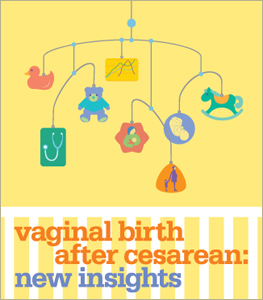Some thoughts on practice guidelines and VBAC as a "vital option"
By: Amy M. Romano, RN,CNM | 0 Comments
 Next week, scientists, policy experts, and advocates will come together for the National Institutes of Health Consensus Development Conference on Vaginal Birth after Cesarean (VBAC). A panel will spend three days reviewing the evidence and hearing public testimony. On Wednesday they'll announce their findings in a press telebriefing.
Next week, scientists, policy experts, and advocates will come together for the National Institutes of Health Consensus Development Conference on Vaginal Birth after Cesarean (VBAC). A panel will spend three days reviewing the evidence and hearing public testimony. On Wednesday they'll announce their findings in a press telebriefing.
The NIH isn't calling their findings 'practice guidelines,' but they're very likely to be taken as such. I'll admit: the concept of guidelines, at least as they are developed and used in the United States, is a little troubling to me. On the one hand, guidelines can represent, as the Institute of Medicine suggests, 'a move away from unexamined reliance on professional judgment toward more structured support and accountability for such judgment.' But what about their limitations?
Guidelines are seen by the public and by health professionals as objective and scientific, but:
Experts often look at the same body of evidence and come up with different conclusions.
- Chauhan and colleagues have demonstrated significant variation across national guidelines in management of shoulder dystocia and intrauterine growth restriction. In other words, the American Congress of Obstetricians and Gynecologists (ACOG) doesn't agree with its counterparts in other countries about how these conditions should be diagnosed and treated.
- A study in the current issue of Birth compared VBAC guidelines from six countries and found little agreement not just on practice and management issues, but on the data itself: they found a four-fold variation in the reported upper-end risk of uterine rupture, as well as significant variation in the reported likelihood of vaginal birth in a VBAC labor.
- In 2008, ACOG reversed its position on the safety of expectant management of prelabor rupture of membranes, without citing any new evidence at all (and despite the publication of new evidence that, if anything, strengthens the argument for expectant management.)
Often, experts aren't even looking at the same body of evidence.
- In the comparative study of national VBAC guidelines, 22 individual references were cited for uterine rupture, none of which appeared in all six guidelines. Only two studies were cited in three of the national guidelines and an additional 5 studies were cited in two national guidelines.
- In the shoulder dystocia review only half of eligible references were cited in both of the national guidelines the researchers analyzed.
- In the review of intrauterine growth restriction, only 12% of references were cited in both national guidelines.
- Guideline authors rarely if ever include a rationale for why they included the studies they included and excluded others.
The evidence they are looking at is often limited or flawed.
Even when guidelines are evidence-based, they're often ignored.
- When ACOG issued new guidelines about fetal heart rate monitoring in labor last year, blogs and Twitter went nuts with the news that they had finally admitted that intermittent auscultation is safe and effective, and that continuous electronic fetal monitoring doesn't live up to its many promises. I pointed out at Our Bodies, Our Blog that ACOG hadn't changed a single word of its guidelines with respect to intermittent auscultation and the limitations of EFM; it's just that their recommendations had been ignored. (No surprise: they're still being ignored.)
And then there's the not-so-small issue that guidelines suggest that a 'one size fits all' approach will translate into the best care for everyone, which anyone who takes care of patients or has been a patient recognizes is flat-out false. We all have different reasons for making the health choices we do. An individual's informed consent or refusal can and should trump guidelines, but in practice, guidelines dictate practice and policy for all women. Case in point: the last time ACOG issued VBAC guidelines, hospitals and care providers began banning vaginal birth outright in women with prior cesarean surgery. The VBAC rate in this country plummeted virtually overnight.
The International Cesarean Awareness Network is hosting a blog carnival on the theme, 'Why is VBAC a Vital Option?' I suspect we're going to hear a huge range of responses, along with some stories of the astounding lengths some women have gone to in order to ensure that VBAC remained a viable option for them. Not every woman goes to these lengths - plenty of women are perfectly happy to have repeat cesareans and would make that choice even if VBAC was offered and supported - but these stories underscore the fact that blanket guidelines will not apply to every woman everywhere.
Despite all of this, I'm actually rather optimistic about the NIH VBAC Conference. In my mind, the situation around VBAC has gotten so bad in this country that a fresh look at the issues and the evidence can only help matters. Plus, the meeting comes on the heels of major recommendations for maternity care reform and the conference findings are likely to echo and lend credence to many of these. Judith Rooks shares six more reasons we should be optimistic about the upcoming meeting. And last but not least, there is a huge consumer contingent planning to have their voices heard at this conference either in person or by webcast, and many of them are connected via social networks to a far greater number of consumers. You can hear me and Lamaze President-Elect Debra Bingham on The Feminist Breeder's Blog Talk Radio Show on Monday, recapping Day One of the proceedings.
Published: March 02, 2010
Tags
CesareanVBACACOGMaternal Infant CarePractice GuidelinesNIH Consensus Conference